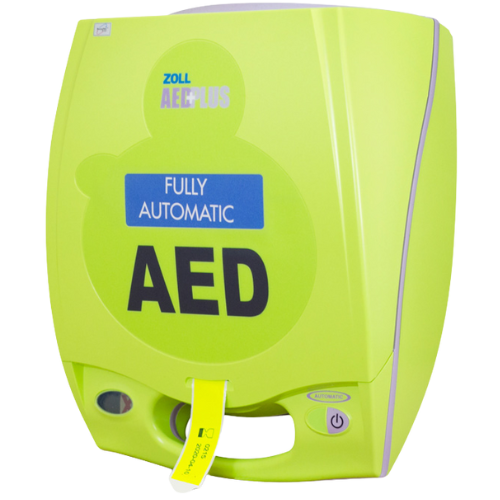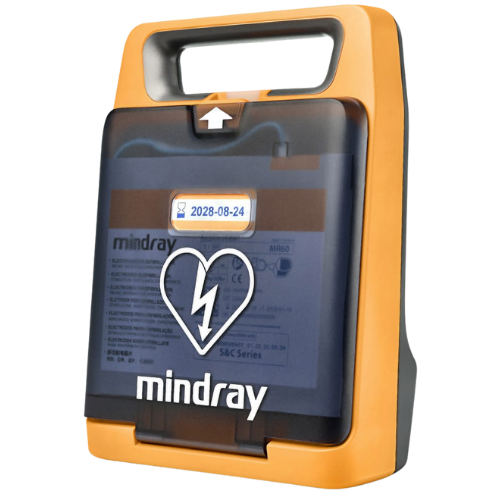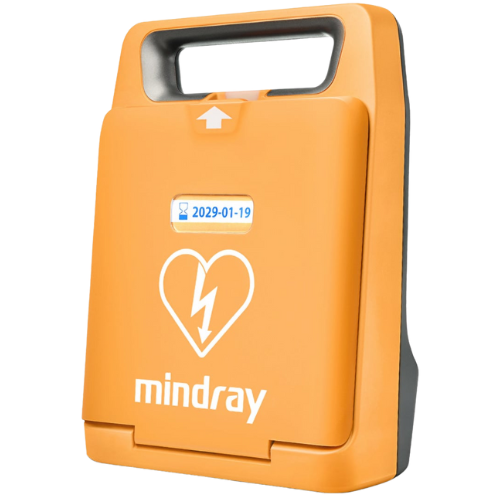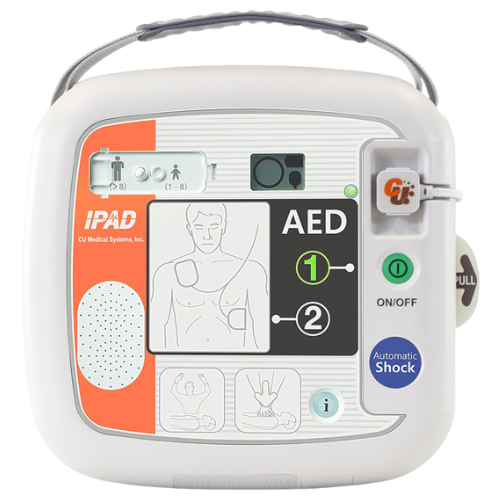How to Use a Defibrillator: Step-by-Step Guide
A defibrillator is a portable device used to treat sudden cardiac arrest (SCA). This article will help you learn how to use a defibrillator.
A defibrillator analyses the heart's rhythm and, if necessary, delivers an electric shock to help restore a normal rhythm.
They are designed for use by members of the public, including those without medical training. They provide clear visual and voice instructions, making it possible for bystanders to respond quickly in an emergency.
According to the Resuscitation Council UK, early defibrillation is a key link in the “chain of survival”, the sequence of actions that give someone the best chance of surviving cardiac arrest. Using a defibrillator within the first few minutes can significantly improve outcomes, especially when combined with immediate cardiopulmonary resuscitation (CPR). This article aims to address the most useful information when learning how to use a defibrillator..
Did You Know?
Most modern defibrillators can detect whether a shock is needed, they will not deliver one if the heart rhythm is not shockable.
Human Observation
In many public spaces, defibrillator cabinets are present but not easily noticed unless highlighted with signs or floor markings.
Understanding When and Why to Use It
Sudden cardiac arrest (SCA) happens when the heart stops pumping blood effectively due to an electrical malfunction. It differs from a heart attack, which is caused by a blockage reducing blood flow to part of the heart muscle. A heart attack can lead to cardiac arrest, but the two are not the same.
In a cardiac arrest, the person collapses suddenly and becomes unresponsive. They will not be breathing normally, and their heart may stop beating altogether. This is a medical emergency requiring immediate intervention.
A defibrillator is critical in these moments. It works by analysing the heart’s rhythm and determining if a defibrillation shock is needed. This shock can help reset the heart’s electrical system, potentially restoring a normal rhythm. The chain of survival is very important to know when learning how to use a defibrillator.
The Chain of Survival
The "chain of survival" describes four key steps:
Early recognition and call to 999
Early CPR
Early defibrillation
Post-resuscitation care
The sooner a defibrillator is used, the higher the chance of survival. According to the British Heart Foundation, defibrillation within three to five minutes of collapse can increase survival rates to as high as 50%–70%.
source: https://www.bhf.org.uk/how-you-can-help/how-to-save-a-life/defibrillators
In community settings, defibs are increasingly available in workplaces, transport hubs, schools and sports centres. They are intended for public use and often stored in unlocked cabinets or boxes with instructions.
Preparing the Scene
Before using a defibrillator, it is essential to ensure that the environment is safe for both the responder and the casualty. This step helps prevent further harm and ensures the defibrillator can be used effectively.
Step 1: Check for Danger
Look around for hazards such as traffic, water, or exposed electrical sources. Do not approach the casualty if the scene is unsafe.
Step 2: Assess the Person
Check if the person is responsive. Gently shake their shoulders and shout. If there is no response, check for normal breathing. Occasional gasps are not normal. If the person is unresponsive and not breathing normally, assume cardiac arrest.
Step 3: Call 999
Call 999 immediately or ask someone nearby to do so. Provide the location, explain the situation clearly, and follow any instructions given by the operator. The emergency call handler may direct you to the nearest public defibrillator if one is available.
Step 4: Start CPR
Begin chest compressions straight away. Place the heel of one hand in the centre of the chest, interlock your fingers, and press down hard and fast at a rate of 100–120 compressions per minute. Continue until the defibrillator is ready to use.
Step 5: Delegate Tasks
If other people are present, assign roles:
One person calls emergency services
Another fetches the defibrillator
A third begins or continues CPR
Clear communication and quick action can reduce delays in defibrillation and improve the person’s chances of survival.
Step-by-Step Guide on How to Use a Defibrillator
Defibrillators are designed to be used by the public. They guide the user through each stage with voice prompts and visual instructions. The following steps outline how to use a defibrillator safely and effectively.
Step 1: Switch On the Defibrillator
Open the lid or press the “On” button. The device will begin giving clear spoken instructions. Continue CPR until the defibrillator instructs you to stop.
Step 2. Expose the Chest
Remove or cut through clothing. If necessary, remove underwired bras or metal accessories that may interfere with pad placement. Dry the chest if it is wet.
Step 3. Attach the Pads
Peel the backing off the adhesive pads and place them firmly on the chest:
One pad on the upper right side, just below the collarbone
One pad on the lower left side, below the armpit
Many defibrillators have diagrams or animations showing correct placement.
Step 4. Allow the Device to Analyse
Once pads are in place, stop touching the person. The defibrillator will analyse the heart rhythm. It may take a few seconds. Do not resume CPR until prompted.
Step 5. Deliver the Shock (if Advised)
If the device detects a shockable rhythm, it will either:
Automatically deliver the shock, or
Instruct you to press the shock button
Make sure no one is touching the person. Loudly state “stand clear” before the shock is delivered.
Step 6. Resume CPR Immediately
After the shock (or if no shock is advised), continue chest compressions as directed. The defibrillator will reanalyse every two minutes and guide you through further actions.
Step 7. Keep the Pads in Place
Do not remove the pads. They allow the defibrillator to continue monitoring the heart rhythm. Keep them attached until emergency medical personnel arrive and take over.
According to guidance from the Resuscitation Council UK and the British Heart Foundation, modern defibrillators are extremely safe and will not allow a shock to be given unless it is medically needed.
source: https://www.resus.org.uk/sites/default/files/2020-03/AED_Guide_2019-12-04.pdf
source: https://www.bhf.org.uk/how-you-can-help/how-to-save-a-life/defibrillators/understanding-defibrillators-what-they-are-and-how-to-use-them
Tips and Troubleshooting
Defibrillators are designed for ease of use, but certain situations may require additional attention. The following tips address common challenges when addressing how to use a defibrillator.
Hairy Chests
Excess chest hair can prevent good contact between the pads and the skin. Most public access defibrillator kits include a razor. If the chest is very hairy, quickly shave the areas where the pads will go.
Wet or Sweaty Skin
Moisture can interfere with the pads’ adhesion and the shock delivery. Dry the chest thoroughly with a towel or item of clothing before attaching the pads.
Metal Objects
Remove metal jewellery or underwired bras if they are near the pad placement sites. Metal can conduct electricity and may interfere with pad function, although this is rare. Do not delay treatment, remove only if easily accessible.
Pacemakers or Implants
If the person has a visible pacemaker or implantable device under the skin, avoid placing the pad directly over it. Place the pad at least one inch away to ensure effective shock delivery.
Piercings
Chest piercings near pad placement sites should not delay use. Do not place the pad directly over a piercing, move slightly to the side if needed.
Paediatric Use
Some defibrillators include paediatric pads or a switch to adjust the shock level for children under 8 years or weighing under 25kg. If paediatric settings are not available, adult pads may still be used.
Battery or Pad Expiry
Public defibrillators should be checked regularly to ensure they are functioning. Pads and batteries have expiry dates and must be replaced accordingly. Most devices display a status light to indicate readiness.
The Resuscitation Council UK and St John Ambulance recommend regular inspections and maintenance as part of an organisation’s health and safety procedures.
source: https://www.sja.org.uk/get-advice/i-need-to-know/defibrillator-guide-for-rescuers
Post‑Shock Care and Handover
After using a defibrillator, it is important to continue providing care until emergency medical services arrive. The steps below outline how to manage the situation following a shock, or if the defibrillator advises no shock.
Continue CPR
Whether a shock has been delivered or not, resume chest compressions as soon as the defibrillator prompts you. Maintain the rhythm at 100–120 compressions per minute. Deliver rescue breaths if trained and confident, at a ratio of 30 compressions to 2 breaths.
Follow the Defibrillator’s Instructions
The device will reassess the heart rhythm every two minutes. Continue following all voice prompts. If another shock is required, the defibrillator will advise you to stand clear and deliver it.
Monitor for Signs of Recovery
If the person starts to show signs of life — such as moving, breathing normally, or coughing — stop compressions. Place them in the recovery position and continue to follow the device's instructions.
Prepare for Handover
When emergency responders arrive:
Inform them of the actions taken
Confirm how long CPR was performed
Note how many shocks were given
Do not remove the defibrillator pads — they allow continued monitoring and treatment
Support the Environment
Keep the area clear to allow paramedics access. If indoors, open doors or guide responders to the scene.
In many cases, the defibrillator’s internal memory records data that paramedics may download for clinical purposes. Leave the device attached unless directed otherwise.
Maintenance, Training and Legal Considerations
While defibrillators are designed for public use without training, responsible maintenance and awareness of legal protections are essential, especially for workplaces or organisations managing a device.
Regular Maintenance
Defibrillators should be checked routinely to ensure readiness. Key maintenance points include:
Battery status: Most defibrillators have a visual indicator (e.g. green flashing light) to show operational status.
Pad expiry dates: Pads typically expire every 2 to 5 years. Expired pads should be replaced immediately.
Physical condition: Ensure the device and accessories are clean, intact and accessible.
Some defibrillators automatically perform self-checks and alert users to faults via audible alarms or warning lights.
St John Ambulance and NHS Trusts recommend logging monthly checks and replacing components as needed.
source: https://www.sja.org.uk/get-advice/i-need-to-know/defibrillator-guide-for-rescuers
Training
Although training is not legally required to use a defibrillator in the UK, it increases confidence and improves coordination with CPR. Recommended courses include:
Basic Life Support (BLS) with AED
Emergency First Aid at Work (EFAW)
Courses by the Resuscitation Council UK, British Heart Foundation or St John Ambulance
Trained individuals can respond more efficiently, but untrained members of the public should still use a defibrillator if needed. Devices are safe, and voice prompts guide every step.
Legal Protections
In the UK, Good Samaritan principles apply. If you attempt to help someone in cardiac arrest using a defibrillator, you are legally protected, provided your actions are reasonable and in good faith.
You do not need consent to use a defibrillator on someone who is unresponsive and not breathing normally. This is covered under the concept of implied consent in emergencies.
Did You Know? (Fact Box)
First public defibrillator: The first fully automated public-access defibrillator was installed in 1994 in Chicago’s O’Hare International Airport. Airports remain among the highest-priority sites for defibrillator availability due to high footfall and travel stress factors.
UK survival rates: According to NHS England, fewer than 1 in 10 people survive an out-of-hospital cardiac arrest. However, this can rise to 7 in 10 when CPR and defibrillation are provided within 3–5 minutes
Shock advice safeguard: A defibrillator will only deliver a shock if the person is in a shockable rhythm (usually ventricular fibrillation or pulseless ventricular tachycardia). It will not allow a shock if it is not medically appropriate.
Community defibrillators: Many UK towns and villages now maintain public defibrillators in heated, unlocked cabinets. These are often marked with a yellow or green box and can be accessed by dialling 999 for a code.
Human Observation
In many community and workplace environments, defibrillators are technically available but not always easy to locate. Despite guidance on optimal placement, devices are sometimes installed:
Behind reception desks
In locked offices outside public hours
Without clear wall signage or floor markings
In contrast, highly visible installations — such as green wall-mounted cabinets with overhead signs or high-visibility stickers — tend to draw immediate attention during emergencies. Some even include flashing lights or audible alerts when opened.
Routine signage checks and staff awareness can improve accessibility. It’s also beneficial to include defibrillator locations in fire safety inductions or workplace first aid plans.
Frequently Asked Questions (FAQs)
-
Yes. Defibrillators are designed for use by untrained bystanders. They give clear voice instructions and only allow a shock if it is necessary.
-
No. A defibrillator will not deliver a shock unless it detects a shockable rhythm. You cannot make the situation worse by following its instructions.
-
Yes. Many defibrillators include paediatric pads or a setting for children under 8 years or weighing under 25kg. If paediatric options are unavailable, adult pads can still be used.
-
No. Clothing must be removed to expose the chest. Pads need direct contact with dry skin to work properly.
-
Avoid placing the pads directly over a pacemaker or piercing. Position the pads slightly to the side, following the diagram on the device.
-
No. Leave the pads in place. They allow continued monitoring, and emergency responders may need the data recorded by the defibrillator.
-
No. In the UK, Good Samaritan protections apply. You are legally protected if you attempt to help someone in cardiac arrest in good faith.
Sources
Below is a list of the live sources used to create this article, along with a brief description of what each contributed:
British Heart Foundation – Understanding Defibrillators
Clear public-facing information on what a defibrillator is, how it works, and common questions about safety and usage.
https://www.bhf.org.uk/how-you-can-help/how-to-save-a-life/defibrillators/understanding-defibrillators-what-they-are-and-how-to-use-themSt John Ambulance – AED Maintenance and Rescuer Advice
Guidance on maintenance responsibilities, legal considerations, and common troubleshooting issues such as wet skin or hair.
https://www.sja.org.uk/get-advice/i-need-to-know/defibrillator-guide-for-rescuersEast London NHS Foundation Trust – AED and BLS Training Document
Details on workplace training expectations, equipment checks, and staff responsibilities in healthcare environments.
https://www.elft.nhs.uk/sites/default/files/2022-03/adult_basic_life_support_and_automated_external_defibrillation.pdf






